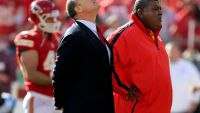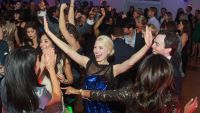Having scattered the blue jays, mockingbirds and others from one of the taller trees along a trail in west Houston, Cisco, a red-tailed hawk, had no intention of flying back to keeper Charles "Chuck" Redding.
Despite Redding's whistles and entreaties, Cisco stayed put high in the tree and then led Redding in pursuit to a nearby neighborhood along Dairy Ashford.
Redding's outing with Cisco, who had a tracking device attached to his back, wasn't going quite as planned on this recent crisp, bright morning.
"You have to be really patient," said Redding, waiting with pole in one hand and gauntlet on the other.
The west Houston resident is one of a few licensed falconers in the Houston area and one of only 245 in the state, according to Megan Russell, of the Texas Parks and Wildlife, which issues falconry permits.
As well as Cisco, Redding, 61, has a 2-year-old female Harris hawk called Farrah, who on this particular morning was waiting in the hawk box in the car. With Cisco on the run, Farrah wasn't going to get out and hunt. She would have to wait for another day.
Described as an art, the sport of falconry requires study, patience, skill, resources and long hours. The falconer has to first capture and then train a hawk or falcon to fly free, hunt and accept a return to captivity.
In Texas, a would-be falconer must apprentice with a licensed falconer for at least two years and pass an exam before being issued a permit, of which there are three levels - apprentice, general and master.
Russell said falconry permits allow the raptors to be kept to train for use in the sport of falconry.
"Some of the falconers treat their raptors as well as some people treat their dogs or cats, but they are not kept as pets," Russell wrote in an email.
Redding's interest in hawks began when he was a teen in rural northern Illinois and he trained some red-tailed hawks. That interest was revived almost 10 years ago. Redding found a sponsor to train him and became a licensed apprentice falconer in 2004, capturing his first bird that same year.
Since then Redding, who retired in June from a career as a mechanical engineer, is now a general licensee, has had seven birds, including Cisco and Farrah.
"I just love these birds," he said. "To me, it's thrilling to watch these wild creatures hunting. It's a very intense and important part of nature."
Redding takes 7-year-old Cisco, a brown-hued, 2-pound bird with a 4-foot wing span, and Farrah, a slighter bird with charcoal and white coloring, out to hunt separately at least three times a week.
They go to what Redding described as "scrubby" spaces in and around Houston where there is a good chance of catching rabbits, squirrels, rats and mice.
Redding takes the food home to freeze to feed the birds during the off-season, which is from the end of March to October.
When not hunting, the birds hang out in a screened enclosure, kept cool by a fan, at Redding's west Houston home.
While there are critics of the sport, Redding said falconers help prolong the lives of the birds and must abide by strict rules dictated by the state.
"If you are just looking at a bird's chances of living a long life, it's very remote," he said.
"It's a continuous battle to keep them surviving."
He said the birds live longer, healthier lives under the care of falconers, and that as a community falconers helped bring back the once-endangered peregrine falcon.
For more information about Redding, visit his website at http://virtualvideo.cc/falconry/index.html.
Annette Baird is a freelance writer who can be reached at anbaird@sbcglobal.net


























 Reddit
Reddit Slashdot
Slashdot StumbleUpon
StumbleUpon Tumblr
Tumblr Twitter
Twitter Yahoo! Buzz
Yahoo! Buzz Delicious
Delicious Digg
Digg Facebook
Facebook FriendFeed
FriendFeed LinkedIn
LinkedIn MySpace
MySpace












 Facebook
Facebook Twitter
Twitter LinkedIn
LinkedIn Newsletters
Newsletters RSS
RSS




New to the site?
To use commenting, you need to sign up.
Already a member?
Forgot Password? Please log in.